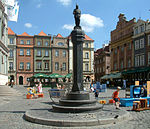St. John Cantius High School, Poznań, Poland

St. John Cantius School is a high school in Poznań, Poland named after the scholar and theologian St. John Cantius. It was founded in 1920 by Gotthilf Berger, Edward Raczyński and Hipolit Cegielski, in place of the German-language high school previously known as Friedrich Wilhelm Gymnasium, in honor of Frederick III. Between 1853 and the First World War the Polish-German sections of the school were known also as the Real School and the Berger Gymnasium after G. Berger. Some notable alumni include: Florian Marciniak, Władysław Niegolewski, Zbigniew Zakrzewski, Xaver Scharwenka and Zygmunt Gorgolewski. Noted faculty members included Hermann Loew and Karol Libelt.
Excerpt from the Wikipedia article St. John Cantius High School, Poznań, Poland (License: CC BY-SA 3.0, Authors, Images).St. John Cantius High School, Poznań, Poland
Strzelecka, Poznań Stare Miasto
Geographical coordinates (GPS) Address Phone number Website External links Nearby Places Show on map
Geographical coordinates (GPS)
| Latitude | Longitude |
|---|---|
| N 52.404444444444 ° | E 16.932777777778 ° |
Address
III Liceum Ogólnokształcące im. św. Jana Kantego
Strzelecka 10
61-845 Poznań, Stare Miasto
Greater Poland Voivodeship, Poland
Open on Google Maps











